
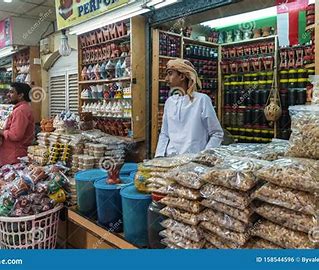
Souq Al Hafa Salalah: Hidden Secrets Only Locals Know
Souq Al Hafa Salalah stands as one of Dhofar Governorate’s most important landmarks that welcomes visitors 24 hours a day with its blend of modern design and ancient architectural character. Most tourists spend 2-3 hours at this leading attraction, but we found much more beneath the surface.
Our closer look at this cultural hub near the Sultan’s Palace revealed a rich source of experiences. The market offers everything from aromatic frankincense and traditional Omani crafts to local delicacies like Shuwa. We found hidden corners and local secrets that make this market truly special and we’re excited to share what we learned with you.
History of Souq Al Hafa Through Local Eyes
Al Hafa Souq sits peacefully among coconut trees in the heart of Salalah, close to the Sultan’s palace. People first knew it as Al Husn Souk. The market got its name from the Haffa District, which started its rich cultural trip.
From fishing village to tourist hub
The traditional marketplace has grown from a small trading post into a 70-hectare waterfront development over the last several years. A 4.5km central shoreline overlooking the Indian Ocean marks this change, where local fishermen used to bring their daily catch. The area has become the second-largest old market in Oman.
How locals shaped the market
Local community roots run deep through Al Hafa’s veins. The market became prominent as the “Frankincense Souk of Oman.” Local traders who managed to keep its cultural essence passed this legacy through generations. The development plans have:
- A 120,000 square meter Heritage Village that shows maritime traditions
- Local architectural elements and building styles
- Special areas to display traditional craftsmanship
Key historical events
The market’s most important change started with the Al Hafa Waterfront project announcement. This bold development covers 60,000 square meters and marks a crucial moment in the souq’s history. The project has a heritage souq that serves as an alternative to the current market and preserves local architectural elements.
The development plan has lush farmlands that create a perfect mix of traditional and modern elements. Small and medium enterprises now thrive among international brands. This balance between progress and preservation remains strong. The market stays true to its roots and continues to serve as a vital hub for social gatherings and community events.
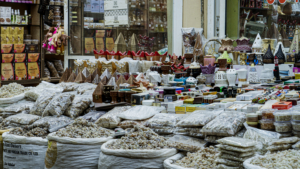
Best Hidden Spots in the Souq
Souq Al Hafa’s open-air pathways reveal a world of unexpected treasures at every turn. This market stands out from typical Arabic souqs with their covered alleyways. Its open layout creates a welcoming space that beckons you to explore.
Local vendor corners
The vendor corners form the soul of Souq Al Hafa. Local merchants are happy to share stories about their crafts and traditions. The textile shops and perfumeries stand out, as the sweet scent of frankincense and bokhur fills the air.
Small family-run stalls lie beyond the main paths. They sell:
- Traditional textiles and authentic Omani garments
- Gold and silver crafted jewelry
- Handmade pottery and local artifacts
- Fresh dates and traditional sweets
- Various grades of frankincense, from Royal Hojari to medicinal varieties
Secret alleyways
The market’s winding alleys take visitors back to a different time. The paths near Al Husn Palace showcase traditional architecture that tells Salalah’s rich story. These hidden passages lead to cozy local cafes that serve the most authentic Omani dishes.
Small shops tucked away in quiet corners hold the true magic of the market. These peaceful spots, surrounded by coconut palms, give you a break from the main market’s energy. You’ll see skilled artisans at work here, creating an authentic Arabian atmosphere that most tourists never see.
The energy grows as you explore these hidden corners. Local vendors share their wares and pieces of their cultural heritage. Each alley brings new surprises, from spice stalls filled with rich aromas to beautiful displays of traditional craftsmanship.
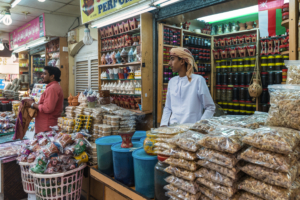
When to Visit: A Local’s Timeline
Timing is a vital part of experiencing Souq Al Hafa’s authentic charm. The market’s atmosphere changes throughout the day and each time slot gives visitors something different to experience.
Peak shopping hours
The market is open from early morning until midnight. Each day has three distinct periods with their own character. European visitors fill the morning hours during winter months from October to April, looking for authentic experiences. The market takes a break from 12 PM to 4 PM and then reopens for evening visitors. The night hours until 10 PM are especially lively with a mix of tourists and locals.
Seasonal changes
Souq Al Hafa completely transforms during the khareef season from late June to early September. Visitors can enjoy pleasant temperatures in the mid-twenties Celsius, which is a welcome break from May and June’s heat that can go above 30°C.
The market shows different faces across seasons:
- Winter (October-April): Temperatures stay in the mid-to-late twenties
- Summer Khareef (July-August): Visitors peak during this time with light drizzle and green landscapes
- Post-monsoon (September): The scenery changes as everything gradually dries up
Festival times
The Salalah Tourism Festival runs during khareef season and brings crowds to the souq. July and August see the highest number of visitors. Extra shops appear to handle all the tourists during this busy time.
Eid Al Adha vacation is another busy period when finding a place to stay becomes challenging. Visitors should plan ahead during festivals since hotels fill up quickly. The market stays open longer during these celebrations and visitors can enjoy better shopping and local entertainment.
Insider Tips for the Best Deals
Becoming skilled at shopping at Souq Al Hafa needs you to know the pricing patterns and local customs. The market sells everything from frankincense to handcrafted souvenirs, and each item has its own value and room for bargaining.
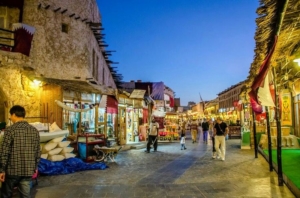
Price ranges for common items
Frankincense is the market’s signature product, with prices that start at 1 Omani rial (about 2-3 dollars). The premium Hawjari variety, known for its silver color, costs more. Shoppers can find many traditional items like clay pot burners, charcoal, and customized souvenirs.
Some sellers have combo packages with burners, charcoal, and frankincense. Buying items separately often saves you money. The market specializes in customized items such as fridge magnets, jewelry, and pens with custom engravings.
Negotiation strategies that work
Bargaining isn’t optional at Souq Al Hafa – sellers expect it. Merchants respect customers who take part in this time-honored tradition. Here’s how to get good deals:
- Check multiple stalls to compare prices
- Carry cash since many vendors don’t take cards
- Build rapport through conversation
- Accept tea when offered – it’s part of the experience
- Ask for package deals when buying multiple items
The best deals come through patience and understanding the culture. Time spent drinking tea and talking about products with vendors creates a genuine shopping experience.
Red flags to watch for
Smart shopping means staying alert to possible issues. Shops that won’t negotiate should raise concerns – it goes against market traditions. You should also check product authenticity, especially with frankincense grades like Shazri, Najdi, Sha’abi, and Hawjari.
The best time to visit is outside peak afternoon heat when many shops close. Having a local friend is a great way to get authentic items and fair prices. Look at products with care – real frankincense comes in different forms, from medicinal resin nuggets to essential oils.
Check the weight when buying frankincense since prices change based on quality and quantity. You’ll find everything you need for the complete frankincense experience, including burners and charcoal. With careful observation and good timing, you can get authentic items at fair prices while enjoying the traditional market atmosphere.
Local Food Secrets
The Souq Al Hafa’s culinary scene comes alive with a mixture of aromas and flavors that gives you an authentic taste of Omani culture. Traditional coffee rituals and innovative local creations make the market’s food scene a feast for all senses.
Hidden food stalls
Local vendors bring the market to life with a vibrant street food scene that showcases Omani culinary traditions. Note that the authentic dishes available here include:
- Shuwa – slow-cooked lamb that melts in your mouth
- Harees – a hearty wheat and meat preparation
- Shawarmas and Falafels – perfect for quick bites
- Kunafa and Halwa – traditional sweet delicacies
Small local cafes scattered throughout the souq serve the most authentic fare. These modest establishments known to locals serve strong black Arabic coffee paired with fresh dates – a quintessential Omani ritual.
Salalah’s chefs show their creative spirit through unique offerings like Frankincense ice cream and specialty teas. You’ll find innovative fusion dishes that blend local ingredients with modern techniques alongside traditional treats. The seafood selections give visitors a glimpse into Salalah’s coastal culture.
Best times for fresh produce
The freshest local products are available during early morning visits. Fruit huts near the market display plenty of fresh coconuts, bananas, and papayas. These refreshing treats help you cool down after seeing the market’s many corners.
The street food markets come alive during specific times:
- Morning Hours: Ideal for fresh produce and traditional breakfast items
- Evening Hours: Perfect for experiencing the full range of prepared dishes
- Festival Periods: Special food stalls emerge with seasonal delicacies
Local vendors are happy to share their culinary knowledge and offer samples of traditional snacks and drinks that showcase authentic Salalah flavors. Each dish tells a story of tradition and heritage, making it more than just a meal – it’s an immersion into local food culture.
The market’s food scene shows a colorful mix of tastes that reflects the region’s rich culinary history. Food adventures by the Arabian Sea range from fancy dining spots to lively market stalls. Small and medium-sized food enterprises add their unique flavor to the market’s gastronomic identity.
Restaurants near the market serve substantial meals featuring traditional dishes for anyone wanting authentic Omani cuisine. These establishments keep time-honored recipes passed down through generations to ensure visitors taste genuine Omani flavors. Street food, fresh produce, and traditional restaurants together create a complete food trip through Omani culture.
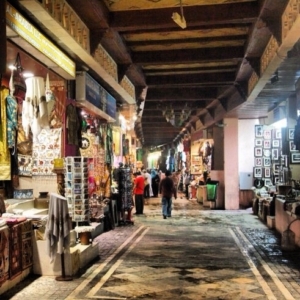
Conclusion
Souq Al Hafa is not just another market – it’s the beating heart of Salalah’s cultural heritage. We found a place where old traditions blend naturally with modern commerce. This market creates an experience that goes way beyond the reach and influence of typical tourist spots.
A local guide’s knowledge makes a real difference in this 70-hectare wealth of treasures. You’ll get the best deals on premium Hojari frankincense in the morning hours. The authentic Shuwa tastes even better as evening approaches. The market changes with the seasons, and the khareef brings special chances to see Salalah’s many faces.
Bargaining is key to the real souq experience. We learned it works best as a friendly cultural exchange instead of just buying and selling. This same idea applies to trying local foods. A quick chat with vendors helps you find hidden food treasures and local specialties you might miss otherwise.
We spent countless hours in every corner of this historic marketplace. Souq Al Hafa gives its best to people who dig deeper. The real magic isn’t just about what you buy. The true value lies in the stories you’ll hear, the people you’ll meet, and the traditions you’ll see up close. Where will your dreams take you? Let’s make it real and Book Now!
